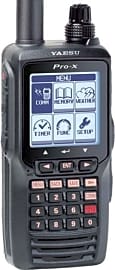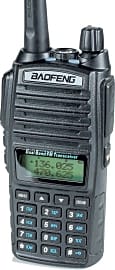The 10 Best Handheld VHF Transceivers

This wiki has been updated 38 times since it was first published in October of 2016. Handheld marine and aviation VHF radios will serve as your lifeline the next time you leave land, whether by plane or by boat. We've come up with a selection of transceivers that includes basic and sophisticated models that vary in range, power, battery life, display, and price, and most of which are incredibly easy to program and use. Keep one charged up and close by in case of emergencies. When users buy our independently chosen editorial recommendations, we may earn commissions to help fund the Wiki.
Editor's Notes
December 01, 2020:
For safety at sea or in the air, a handheld VHF transceiver is an essential back-up for offshore sailors and a primary safety device for in-shore fishing enthusiasts. For aviators who will often run bigger, more powerful systems with a longer range, these hand-held units are helpful for the hobbyist and vital in any situation where you have lost primary communication systems.
We have added the BaoFeng UV-82HP as it is a much newer model than its predecessor, with better power settings, longer battery life, and comes with an ear-piece that the previous model was lacking. Similarly, the Uniden Atlantis 155 replaces an older unit as it combines a class-leading screen size with a better waterproof rating than the Uniden MHS75 at a better price.
The Standard Horizon HX40 is a popular brand that has stood the test of time and is one of the most compact radios on the list. It has an impressive range for its size, as well as a huge battery capacity. Its addition as the latest model was an easy decision, especially when you consider its obvious value for money.
August 06, 2019:
A pair of transceivers from our previous ranking were sent packing to make room for some newer, better offerings. One of the eliminated products was the Cobra HH425LI, which we replaced with the company's somewhat more capable HH450, the top power of which beats out the 425 by a watt, and that can make a big difference if you need your signal to travel. We also sent off the Luiton 10W LT-188H. Its lack of a digital interface made it susceptible to elimination, especially given the great new models we've added. Among those, one of the coolest is undeniably the Icom GMDSS Portable, which is completely idiot-proof and designed to live on survival craft like lifeboats. We're also pretty excited about our new number one pick, the Icom ID-51A Plus2, which boasts in incredibly comprehensive interface and built-in GPS.
VHF Vs. UHF
That means that the distance between peaks in a waveform for ultra high frequency signals is less than that of very high frequency signals.
If you are in the market for a handheld radio transceiver, chances are you've seen the handful of models in either the UHF or VHF frequency ranges. Understanding the nuances of each type of device can help lead you to making a decision between the two that will best suit your needs. In order to understand those nuances, you must first come to terms with the differences between UHF and VHF ranges.
UHF stands for ultra high frequency, where VHF stands for very high frequency. In the case of radio signals, ultra is higher than very. That means that the distance between peaks in a waveform for ultra high frequency signals is less than that of very high frequency signals. Specifically, wavelengths in the very high frequency spectrum will range anywhere between 1 and 10 meters in length, where waveforms in the ultra high frequency spectrum will range between one decimeter and 1 meter in length.
That difference in length is crucial, because it correlates directly to the behavior of each frequency range. Because an ultra high frequency signal has such smaller wavelengths, it has an easier time moving through solid objects like wood, steel, concrete, and other obstructions. VHF signals, thanks to their increased wavelength, can travel greater distances than UHF signals, but each time they pass through a window or a wall, the strength of that signal is significantly reduced.
This is essentially why VHF transmitters are preferred in open areas like the sea or the sky where there are very few obstructions to speak of. Even on hilly ground, VHF is preferable, as longer wavelengths have a tendency to hug the earth. UHF signals, on the other hand, are preferable in urban environments or anywhere that significant obstructions may abound. In these environments, you need a signal that can travel through materials without losing too much power.
So, if you know that the majority of your radio needs are going to take place in the middle of a city or town, or inside a building of any kind, it's probably a smart idea to reach for a UHF transceiver. If, on the other hand, the bulk of your radio needs are outdoors in rural settings, on the open water, or even in the air, a good VHF unit is the way to go. You can still use a good UHF unit outdoors, especially if the distances across which you need your signals travel are short and the terrain is relatively flat, but if it's in your budget, it'd be smarter to reach for that VHF model.
The Right Handheld VHF Transceiver For You
Choosing a handheld VHF transceiver isn’t going to be the hardest decision you've ever had to make, as many of the models on our list are likely to suit your needs rather well. There are some features on certain models, however, that might make one seem that much nicer to you than another.
One of the most basic features that you'll find on the majority of handheld VHF transceivers is some kind of LCD monitor.
One of the most basic features that you'll find on the majority of handheld VHF transceivers is some kind of LCD monitor. If you're on a very tight budget, there are models out there that eschew the monitor entirely in favor of low-cost and increased battery life. Often, the programming and channel settings on such stripped-down transceivers will be rather simplistic, and you'll likely have to refer to your user's manual to know which number or channel corresponds to what radio frequency.
If you choose to go with a model that has some sort of LCD readout, what exactly that read out displays can make a world of difference in your usage. Some models stop at simply conveying channel information and battery life, while others allow you to actively program the transceiver right there on the screen. These kinds of features are especially helpful to individuals on boats or in planes whose hands and eyes are often too busy to go diving around through menus trying to find the right channel for a certain task. A programmable transceiver will offer users fast access to their most frequently used channels, so that they can navigate their radio by little more than muscle memory.
Beyond those considerations, you want to look at things like battery life, charge time, and the power output of a given transceiver. Longer battery life, shorter charge time, and more power are obviously all good things to have, but you need to compare these numbers to your practical needs to make sure that you're not overpaying for a given model or missing out on other valuable features in the name of one of these others.
You Can Never Be Too Prepared
If you live in a predominantly rural area, and you're investing in a VHF transceiver as part of an emergency preparedness kit, then you ought to be commended. Not everybody has the foresight to keep the right materials around to protect themselves and their loved ones in the event of a natural or man-made catastrophe. A VHF transceiver will allow you to communicate with others in your vicinity, and to stay up-to-date on weather and news reports that could mean the difference between life and death. And purchasing a handheld unit is that much smarter, as you can take it with you if you need to evacuate.
The downside to these bags, however, is that they take a one-size-fits-all approach to your survival.
When assembling a survival kit for emergency scenarios, you can go the simple route and grab a fully assembled bug out bag that contains everything one to four people would need to survive for several days. The downside to these bags, however, is that they take a one-size-fits-all approach to your survival. It may be smarter than to invest in the materials for a good bug out bag one at a time.
To that end, you want a large, strong backpack, perhaps even a camping pack with an external or internal frame that can hold all of your materials. Additionally, you want several strong flashlights, food rations, potable water or at least water purification tablets, and any tools like knives, compasses, or paracord that could come in handy.















